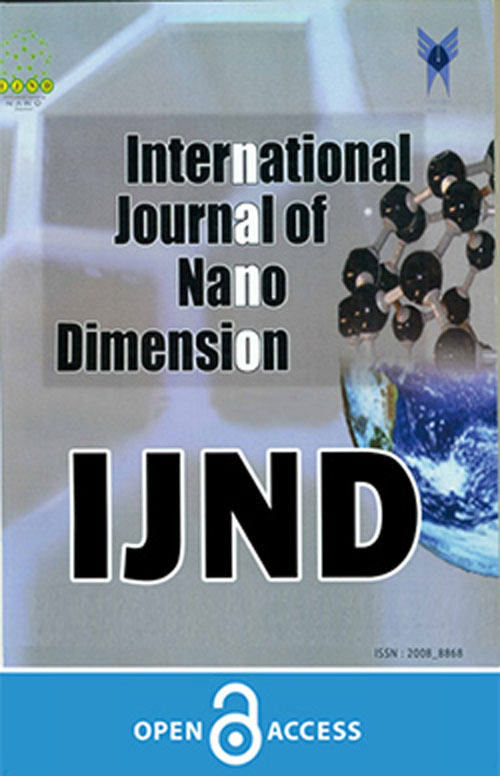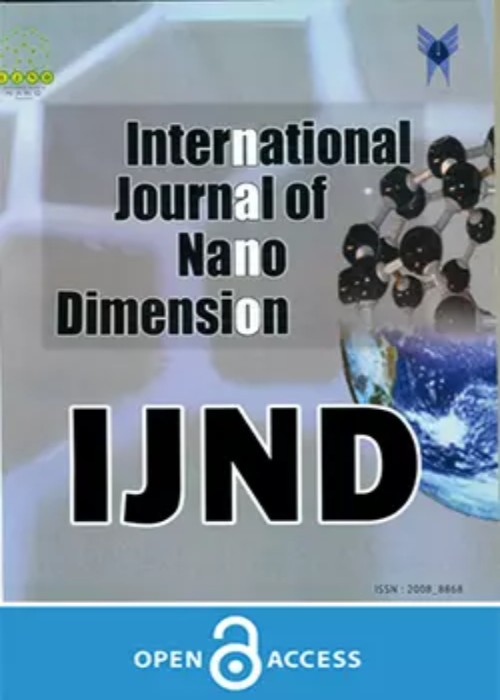فهرست مطالب

International Journal of Nano Dimension
Volume:11 Issue: 3, Summer 2020
- تاریخ انتشار: 1399/04/11
- تعداد عناوین: 10
-
-
Pages 205-214The present paper describes the preparation and characterization of Polyvinyl Alcohol-Polypyrrole-Silver Nanocomposite (PVA-PPy-Ag NC) films. The prepared films were conducting, freestanding, flexible, and robust. Silver nanoparticles (Ag NPs) were synthesized from an aqueous solution of silver nitrate using trisodium citrate as a reductant. The casting solution for the films was prepared by in-situ chemical oxidative polymerization of pyrrole. This was done in the presence of Polyvinyl Alcohol and suspension of pre-synthesized silver nanoparticles. The absorption band at 424 nm in UV-Visible Spectroscopy of silver nanoparticles confirmed the formation of Ag nanoparticles. Scanning Electron Microscopy (SEM) studies revealed that spherical Ag NPs were produced with an average size of ~ 25 nm. The morphological analysis of the synthesized PVA-PPy-Ag nanocomposite films was carried out using Transmission Electron Microscopy (TEM). It was observed in the TEM images that Ag nanoparticles were well dispersed and conjugated in the PVA-PPy matrix. The structure of the produced films was studied by Fourier transform infrared (FTIR) Spectroscopy and X-Ray Diffraction (XRD). X-ray diffraction analysis exhibited the crystalline nature of the silver nanoparticles with a face-centered cubic (fcc) structure. The synthesized PVA-PPy-Ag nanocomposite films can be further utilized as potential material for the fabrication of gas sensors.Keywords: Freestanding Films, nanocomposites, Polypyrrole, PVA, silver nanoparticles
-
Pages 215-221This work investigates the channel thickness dependency of high-k gate dielectric-based complementary metal-oxide-semiconductor (CMOS) inverter circuit built using a conventional double-gate metal gate oxide semiconductor field-effect transistor (DG-MOSFET). It is espied that the use of high-k dielectric as a gate oxide in n/p DG-MOSFET based CMOS inverter results in a high noise margin as well as gain. It is also found that delay performance of the inverter circuit also gets degraded slightly by using high-k gate dielectric materials. Further, it is observed that the scaling down of channel thickness (TSi) improves the noise margin (NM), and gain (A) at the cost of propagation delay (Pd). Moreover, it is also observed that the changes in noise margin (ΔNM = NM(K=40) – NM(K=3.9)), propagation delay (ΔPd = Pd (K=40) – Pd (K=3.9)), and gain (ΔA = A(K=40) – A(K=3.9)) gets hinder at lower TSi. Therefore, it is apposite to look at lower channel thickness (~6 nm) while designing high-k gate dielectric-based DG-MOSFET for CMOS inverter cell.Keywords: Channel Thickness, CMOS, Double-Gate, High-k Dielectric, Inverter Cell
-
Pages 222-236Today, electron leakage in InP-based separate confinement laser diode has a serious effect on device performance. Control of electron leakage current is the aim of many studies in semiconductor laser industry. In this study, for the first time, a new asymmetric waveguide structure with n-interlayer for a 1.325 μm InP-based laser diode with InGaAsP multi-quantum well is proposed and theoretically analyzed using the PICS3D simulation software. The simulator self-consistently combines the 3D simulation of carrier transport, self-heating, and optical waveguiding. Through the simulation, the optical and electrical performances of laser diodes with symmetric and asymmetric waveguides are studied. Numerical simulation reveals that the asymmetric structure exhibits higher output light power, slope efficiency, emission intensity, and series resistance, as well as lower electron leakage and threshold current density under identical conditions, compared with the symmetric structure. The performances are greatly enhanced in the laser diode with asymmetric waveguide design because of the improved radiative stimulated recombination rate, declined non-radiative Auger recombination rate and decreased overlap between the optical wave and the p-doped layer.Keywords: Asymmetric Waveguide, Electron Leakage, InGaAsP, Optimization, PICS3D, Quantum well, Simulation
-
Pages 237-247
In this study, N-methyl-N'propyltrimethoxysilylimidazoliummodified LUS-1 and MCM-48 nonoporous materials were prepared and employed as adsorbent for removing Reactive Blue-19 from aqueous solutions.LUS-1 and MCM-48 were made based on the previous procedure and modified with N-methyl-N'propyltrimethoxysilylimidazolium chloride. XRD analyses did not show any lattice alteration between modified and unmodified adsorbents. A hexagonal mesophase structure with the P6mm symmetry for LUS-1 and IM-LUS-1, and a cubic Ia3d space group for MCM-48 and IM-MCM-48 were observed. UV/Vis spectrophotometry was used to determine of the dye concentration in the solution. Batch studies were conducted in order to find the optimum adsorption conditions and investigation of different empirical parameters like the pH impact, contact time, the amount of adsorbent, and concentration of dye on adsorption process. The best dye removal efficiency of the adsorbents were more than 93% at pH= 3.0-7.0 after about 3 min for IM-LUS-1 and after 30 min for IM-MCM-48. RB-19 dye was desorbed from both of the adsorbents with 10 mL of sodium hydroxide 2 M during 5 min. There was well match between the data and the Langmuir model with maximum adsorption capacities 476.2 mg/g IM-LUS-1 and 277.8 mg/g IM-MCM-48. The reusability of the sorbents were higher than 4 cycles. In addition, removal percent of RB-19 dye from 50 mL of real textile wastewater with 20 mg of IM-LUS-1 and IM-MCM-48 were 93.0 (± 0.6) and 90.2 (± 0.7), respectively. The results showed that this method might be appropriate for removing the pollutant dyes from textile wastewater.
Keywords: Dye removal, LUS-1, MCM-48, N-Methyl-N'propyltrimethoxysilylimidazolium, textile wastewater -
Pages 248-257Interaction of pure and Vn-doped (8, 0), (12, 0) and (16, 0) boron nitride nanotubes with CO molecules was studied using B3LYP/6-311++G(d) theoretical level. Substituting V instead of B atoms, increased the reactivity of nanotube. From the results, the complex stability depends on the direction and the number of the CO molecules interacted with the nanotube. In this work, the quantum molecular descriptors were used for the investigation of boron nitride nanotube reactivity to CO molecules both in the gas phase and in the solution. Also, the influence of the diameter of the nanotube on the electronic properties of the complexes was investigated. The charge transfer in complexes was calculated with NBO analysis. It is expected that Vn-doped nanotubes can be considered as a detector of CO gas molecules.Keywords: Boron nitride nanotube, Detector, Electronic Properties, HOMO-LUMO Gap, V-doped Nanotube
-
Pages 258-266
In this paper, the performance of a CNT-JLTFET under different values of torsional strains of 0, 3, and 5 degrees has been investigated. Simulation has been carried out using non-equilibrium Green’s function (NEGF) formalism in the mode-space approach and in the ballistic limit. The simulation results indicate that, under torsional strain, an increase occurs in the energy band-gap, and thus the on- and off-currents are reduced, thought that reduction has a greater percentage in the off-current, resulting in the increase in the ON/OFF current ratio. Besides, the switching characteristics of the device including power-delay product (PDP) and intrinsic delay (τ) have been studied.
Keywords: Band-Structure-Limited Velocity, Intrinsic Delay (τ), Mode-Space, Power-Delay-Product (PDP), Torsional Strain -
Pages 267-276Plant mediated synthesis of silver nanoparticles (AgNPs) is considered as a representative approach in material synthesis for environmental benignity. In this paper, we report an eco-friendly (green) protocol for the preparation of AgNPs using fruit extract of Michelia champaca L. The color change in experimental solution from light brown to dark brown indicates the resonance of AgNPs and further confirmed by characteristic Surface Plasmon Resonance (SPR) absorption peak at 410 nm using UV-Vis spectroscopy. Fourier Transform Infrared Spectroscopy (FTIR) analysis confirms the presence of phytochemicals like phenols and flavonoids in the fruit extract which are responsible for reduction and stabilization of AgNPs. The biocapping molecules of nanoparticles were possibly stable and were negatively charged as revealed by zeta potential measurement. Further, the size and morphology of the nanoparticles were studied by using Atomic Force Microscopy (AFM) and High Resolution Transmission Electron Microscope (HRTEM) analysis. The AgNPs were evaluated for antioxidant and antibacterial activities. The DPPH radical scavenging assay showed good antioxidant activity of AgNPs (EC50= 532.16 µg/mL) when compared to both fruit extract (EC50= 261.08 µg/mL) and standard ascorbic acid (AS) (EC50= 426.04µg/mL). The AgNPs exhibited potent antibacterial activities against both gram positive and gram negative bacteria. The Pseudomonas aeruginosa (19.00±0.73a mm) showed the highest zone of inhibition at 1000µg/ml concentration of AgNPs solution followed by Staphylococcus aureus (9.00±0.14a mm), Bacillus cereus (10.00±0.19a mm) and Escherichia coli (10.66±0.18a mm). Finally, it can be concluded that AgNPs from Michelia champaca fruit extract showed distinctive free radical scavenging and potent antibacterial activity.Keywords: Antioxidant, Antibacterial activity, Characterization, Michelia Champaca, silver nanoparticles
-
Pages 277-289The purpose of this study is to use the thermal and electrical conductivities of copper oxide nanoparticles and carbon nanotubes for the preparation of high-performance nanofluids for achieving better heat transfer properties. These nanofluids consist of a water/Ethylene Glycol solution containing single-wall carbon nanotubes (SWCNTs) and copper oxide nanoparticles (CuONPs). The effects of such independent variables as CuONPs and SWCNT concentrations, Ethylene Glycol ratio and solution pH were optimized to enhance the Thermal conductivity by the response surface method. The experimental results revealed that adding small amounts of nanoparticles to water/Ethylene Glycol mixtures would improve the thermal and electrical conductivity of nanofluids. The morphology of the nanoparticles was investigated by Scanning and Transmission Electron Microscopy (SEM and TEM) and Energy-Dispersive X-ray Spectroscopy (EDS). For the first time, the electrical conductivity of nanofluids was investigated by electrical impedance spectroscopy. The combined effects of both nanoparticles and nanotubes on thermal and electrical properties of the base fluid were compared to the influence of each on the same base fluid. The electrical and thermal conductivities could be enhanced by 18000 % and 157 % by addition of 0.41 % wt of SWCNT and 1.15 % wt of CuONPs to a 44:56 Ethylene Glycol-water mixture.Keywords: Copper Oxide Nanoparticle, Ethylene glycol, Hybrid Nanofluids, Single-Wall Carbon Nanotube, Thermal conductivity
-
Pages 290-298In this paper, a thin-film InP-based solar cell designed and simulated. The proposed InP solar cell has a periodic array of plasmonic back-reflector, which consists of a silver layer and two silver nanowires. The indium tin oxide (ITO) layer also utilized as an anti-reflection coating (ARC) layer on top. The design creates a light-trapping structure by using a plasmonic back-reflector and an anti-reflection coating layer on top, which increase the light absorption in the solar cell. The enhancement of light trapping was observed in the proposed configuration of the solar cell with an 1000 nm thick InP absorption layer, which improved the short-circuit current density and efficiency. The highest short-circuit current density and efficiency were determined 32.07 mA/cm2 and 26.6%, respectively, for the nanowire radiuses of R1=50 nm and R2= 120 nm. Therefore, this structure improves the ultimate efficiency of 38% compared with the InP-based solar cells counterparts.Keywords: Efficiency, InP Material, light trapping, Nanowire, Plasmonic Solar Cell, Short-Circuit Current Density
-
Pages 299-302
In this study, we reported a facile synthesis of bimetallic FeCo nanoparticles (Fe-Co NPs) by FeSO4.7H2O and Co(Ac)2.4H2O in the presence of sodium borohydride and 2-thiotic acid. The structure and morphology of the nanoparticles were characterized by X-Ray Diffraction (XRD), Energy-dispersive X-ray spectroscopy (EDS), and Transmission Electron Microscopy (TEM). These small, spherical shape and pure phase FeCo bimetallic nanoparticles have saturation magnetization up to 221 emu/g. The results suggest that the long term stable and high saturation magnetization (Ms) FeCo nanoparticles can be used for data storage, catalysis, environmental remediation, high-performance inductors, magnetic hyperthermia treatment and magnetic resonance imaging applications.
Keywords: Bimetallic Nanoparticles, Facile Synthesis, FeCo Nanoparticles, High Saturation Magnetization, Magnetic property


